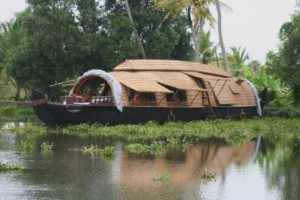 Kerala is a beautiful lush green state in the south. It is quite unlike any other state and offers a gentle introduction to India. With the Western Ghats on one side and the Arabian Sea on the other, the state is influenced by two annual monsoons. There is a strong Christian influence and Christian churches sit alongside Hindu temples. There are not many cows wandering the streets and people are relaxed, easy going and incredibly friendly.
Kerala is a beautiful lush green state in the south. It is quite unlike any other state and offers a gentle introduction to India. With the Western Ghats on one side and the Arabian Sea on the other, the state is influenced by two annual monsoons. There is a strong Christian influence and Christian churches sit alongside Hindu temples. There are not many cows wandering the streets and people are relaxed, easy going and incredibly friendly.
The cuisine is influenced by the ubiquitous coconut and plentiful and varied fresh fish making Keralan food quite distinctive. Accommodation in the region runs from small intimate homestays on tea planatations to a luxury converted boatyard (Brunton Boatyard in Cochin, one of my favourite hotels in India.) It is a wonderful destination for a holiday and is especially fun during festival time.
Places of Interest:
BACKWATERS
Undoubtedly one of the most peaceful ways to travel. The boats are converted rice barges with their own staff of three to cook and cater for your every need. The boats meander down canals, allowing the visitor a unique opportunity to observe everyday life, Keralan style. It is the perfect way to relax with a good book and something cool to sip. Most people find one night sufficient to unwind then combine it with a hotel on the beach for sheer luxury.
THE HILLS
Black pepper is a spice indigenous to Kerala and has been in demand around the world since the Arabs and Phoenicians discovered this part of India and took back the spice to the Greeks and Romans. It became known as “black gold” and was the reason everyone wanted to control this region. Today Kerala produces 97% of India’s pepper production with Kochi at the centre of trading. Nowadays pepper is only one of a number of spices growing in the Cardamom Hills.
A trip into the hills of tea, coffee, spice and rubber plantations provides a welcome relief from the humidity of the coast. The pioneering Scottish tea planters in the 1870s felt at home in the refreshing climate around Munnar , 130km east of Kochi. Nowadays it is possible to stay in heritage and homestay properties and do tea factory or spice plantation tours.
PERFORMING ARTS
Kerala is rightly proud of its strong cultural roots. The image of a Kathakali actor in bold makeup and flamboyant costume is inextricably linked with Kerala. Traditionally performances are held outside temples and last all night however tourist-friendly versions are available at various cultural centres, particularly in Kochi (Cochin.) At these it is worthwhile going along early and watching the actors (the cast is entirely male) undergoing their dramatic cosmetic transformation.
Kathakali literally means “story-play” and encompasses dance, drama and music from almost 400 years and enacts tales from the epics, mainly the Mahabharata.
Mohiniyattam is the sensual female classical dance form and literally translates as “dance of the enchantress.”
Kerala’s traditional martial arts form is Kalarippayattu and dates back to the 12th century. Students learn yoga exercises to make their bodies flexible and controlled and then they move first to short sticks and a long staff and progress to combat weapons like dagger, sword and shield and spear.
AYURVEDIC TREATMENT
Ayurveda is the science of life. Although it is practised throughout India, in Kerala it follows age old traditional laws. The system here has its own unique characteristics which makes a stay at a Keralan resort so special and invigorating. Treatments taken the monsoon season are especially potent according to practioners.
FESTIVALS
India is renowned for having festivals almost every day of the year but there are two major ones in Kerala worth visiting.
The PURAM festival in Thrissur in April/May is the biggest and best pooram (meeting) held throughout the state. It celebrates the arrival of two goddesses before Shiva. Thousands of devotees crowd around to watch two rows of caparisoned elephants approach each other, with the central elephants carrying the deities. The percussion bands and drums beat out hypnotically and it all culminates in a spectacular firework display.
The ONAM festival is the one for which Kerala is famous. It is a harvest festival which lasts for 10 days in August/ September with elephant processions and special meals, the most elaborate being the Onasadya, a nine course strictly vegetarian meal. Children decorate the entrance to their homes with intricate, colourful patterns of flowers in designs called Pookalam.
However, the greatest crowd puller is the Vallamkali ( or Snake Boat Race.) The most hotly contested is for the Nehru Trophy where around 16 elaborately crafted black wooden snake boats compete fiercely. Thousands crowd the banks to watch up to 125 oarsmen dressed in white turbans and white dhotis, 4 helmsmen and 25 singers of traditional songs called Vanchipattu, rhythmically paddling their boats down the river. Fevered excitement grips both crowd and crew. Colourful and frantic!







